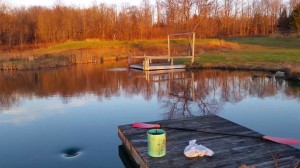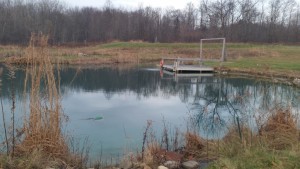I know we’ve been seeing the latest floods in the news and we may have been through a flood ourselves. Another part of the water power is geared more towards water flow or should I say how much water can run through an 8” pipe.
Coming out of winter and the spring rain we install a little longer over flow pipe in the pond to hold a little more water and bring the pond level up closer to the deck. When winter approaches we put the shorter pipe over flow pipe on to lower the water level giving more room for ice to build up without heaving the deck, but we also use our aeration system to help keep the deck ice free.
Sounds simple right? Well it is in a away in spring but fall changing is when it gets a little scary. Let me explain the difference. Once spring arrives we have the shorter pipe on so when I remove that pipe the water level above the pipe is not as high as the fall time of removing the longer pipe. So in spring there is about 6” of water over the top of the pipe and in fall there is about 12” of water over the pipe.
Either way is a bit scary as I am lying on the floating deck with my arms in the water removing or tightening the hose clamp. Once the top section of pipe is removed there is either 6 or 12” of water that is above the pipe (rubber pipe Connector). Now all the water wants to rush out of the pond through the 8” pipe we have for the over flow. With that amount of water focused into the pipe it creates a large vacuum as the water rushes out the pipe.
Think of the vacuum sweeper and putting your hand over it, it wants to pull your hand in right? Well the same thing with the water racing out the pipe, it can pull you in, in a second. If your arm was big enough or body part big enough to cover the pipe you could get stuck on the pipe just like the sweeper, but the chance of getting lose are harder than getting off the sweeper.
It’s not just the 6 or 12” of water above the pipe but all the water that is in the pipe going out the other end that is pulling or creating the vacuum that holds you in place. I’ve heard the stories with larger pipes and folks whole bodies being pulled in and through the pipe, not a pleasant experience or you could be held in place under the water. Either way it is a dangerous act when working on the over flow pipe or any water exit. Just as a side note that if your over flow pipe (stand pipe) is not secure in the pond base it could move by bumping it with the floating deck causing it to tip deeper in the water and lowering the pond.
What I didn’t catch in the video was the first few seconds after removing the pipe. The water just sort of sat there until I broke the surface with the next pipe allowing the water to start into the pipe. When it did it was a like an 8” vacuum hose. Plus the amount of water over the pipe was around 4” at that time and there was not a lot of air space letting the water flow out.
At the other end of the pipe, the exit there is a rock to help break the water flow up so not to trench the yard. Also the pipe at the exit was almost full showing this was just about the max of the pipe for flow. This is where those 100 year rain storms dumps a ton of water into the pond and could max out the flow of the pipe, which leads to over topping the dam unless you have an emergency spillway in place to control the water exit instead of taking a chance of trenching through the dam and losing more water or potentially the dam.
There are cases or at least different pond designs that allow water to go over the dam with no harmful affect but not many. One example is our little pond where we do not have an overflow pipe and just an emergency spillway. You can see this in our free membership under the pond walks video.
That’s about it for this topic, just remember water is heavy, you can’t stop it and as we have seen in the news with the flooding it can wash houses away.



